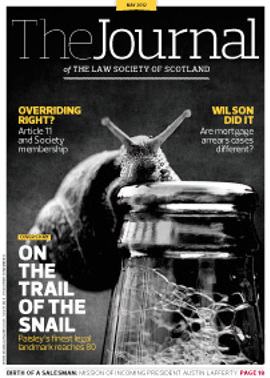Snail of the century

When the Editor assigned me the task of writing this article on the forthcoming major international conference on an obscure Scottish case, he panicked me by requesting discussion on its enduring significance in modern law. Accordingly, my first port of call was the law library, and I am glad I did as it transpires to be rather famous.
Although a recent piece in the Scotsman challenged the description of Donoghue v Stevenson as “the most famous case of all time”, nonetheless even a perfunctory check of the table of cases in any book on the law of negligence will throw up an extreme number of page citations for it, almost as though it punctuates our law. And as the Scotsman pointed out, it is one of only a few cases to have a permanent exhibit at the UK Supreme Court.
Therefore, when this case has its 80th anniversary on 25 May this year, it seems wholly fitting that said major international conference should convene in Paisley, the very town that was its locus delicti, and at last over two years of planning and preparation shall reach fruition for us conference organisers – Renfrewshire Law Centre, the University of the West of Scotland, and the Faculty of Advocates.
Putting aside for a moment lighthearted plays on the notoriety of Donoghue v Stevenson 1932 SC(HL) 31, for us organisers so much has it possessed our attention these last 30 months, that we would propose forevermore it be referred to simply as “The Case”.
Really, repeating its name feels otiose, so hardwired is “The Case” into the psyche of all English-speaking lawyers and many others besides. If it did not seem so to us two years ago at the beginning of our journey, it certainly does now, in the month of our Major International Conference on Tort, Negligence and Delict. It is almost as though “The Case” has become an old friend. The most famous case of all time? We are confident in this claim with no concern for contradiction. “The Case” really does need no introduction. In evolutionary terms, it towers over the legal landscape like a Kubrickesque black monolith.
Pro bono celebrated
Our own journey, however, began more recently on the Isle of Arran in 2009, between Christmas and New Year. Three years prior, I had taken up the position of principal solicitor at Paisley Law Centre, running a range of social welfare cases mostly on legal aid or pro bono. I came to Arran to meet my good friend Joe Bryce, who had recently returned to practice at the bar with a similar interest in pro bono work. We set off on a leisurely stroll over the foot of Goat Fell. There was much talk on many subjects, and even a hipflask of Lagavulin.
Eventually we settled on a discussion on the plight of pro bono in Scotland and the UK, and in that moment on Goat Fell a germ of an idea took root in our minds. Joe and I obviously already knew of “The Case”; we already knew that the incident took place in Paisley; and that the site of the old Wellmeadow Café was situated within 200 yards of my offices and the University of the West of Scotland, with whom we would soon establish a pro bono student law clinic, called Lawwise.
Indeed, so propitious was the proximity of these three locations, and given also the fact that “The Case” was conducted pro bono, it seemed almost decreed by fate that we be duty bound to celebrate its 80th anniversary.
So when Joe and I wandered off Goat Fell and parted company that evening, we had resolved to meet again in Paisley in the New Year for further discussion on our idea. And in the spring of 2010 we set up the Paisley Snail Steering Committee with Dale McFadzean and Briony Cullin of UWS. Lawwise had its official launch in October 2010.
The planning for the conference has proven extremely onerous, yet rewarding, and if ever the enormity of our project appeared too daunting, we took profound encouragement in the professional and public response, both domestic and international. Whether it be the quirkiness of the snail in its bottle, the mystique of May Donoghue’s unnamed “friend”, or the romance of a pro bono lawyer defying the status quo then changing it forever, there seems to be a certain je ne sais quoi about “The Case” that makes people take it to their hearts. Thus mention of organising an event to celebrate it seems to open doors.
Showpiece site?
Yet with it becoming apparent that “The Case” was held in such adulation, there also descended upon us a realisation of the weighty responsibility we had taken on.
Unfortunately, by the start of our journey the site of the old Wellmeadow Café had fallen into dereliction. The café was demolished decades ago, leaving an empty lot. At some point a demure marker stone was erected with an unassuming plaque commemorating “The Case”, and a bench was installed so passers-by could rest awhile and contemplate their reasonable duties. However, by the turn of the millennium the ground had subsided and become overgrown with weeds, the plaque was weathered and obscure, while the bench was missing. One might imagine that if some other nation, America for example, had as proud a boast as Scotland could make of “The Case”, then this site would have a museum on it. However, Scots being Scottish, sometimes we can be taciturnly and culpably humble about such matters.
Now, we already knew there was a conference in 1990, the so-called “Pilgrimage to Paisley”, which was organised by Canadian lawyers including the distinguished Martin Taylor QC, and we knew they had held a procession to mark the event, so we wished to do the same, and naturally envisaged walking to the site of the Wellmeadow Café. However, we could not conceive of bringing honoured conference guests and delegates there in its current state. Thus we set out to lobby the powers that be with a view to the site’s renovation.
Rather inauspiciously, no one seemed to know who actually owned the site. For a moment, another germ of an idea flashed across the grey matter, involving a disposition a non domino with a view to owning this most famous historical real estate. This was fast dispelled by the prospect of assuming proprietary responsibility for a public place in such a bad state of repair, with a less than enviable track record for delictual liability. In any event, inquiry of the Land Register soon revealed the site owner to be none other than Renfrewshire Council. Therefore, Renfrewshire’s Provost, Celia Lawson, leant her moral support to the event, and by mid-2011 the council had drawn up a blueprint for the site’s renovation, with the adjacent Co-op funeral parlour agreeing to share the cost. Moreover, thanks to the efforts and skill of staff and students at Reid Kerr College, the bench has been replaced with a sturdy hand-carved facsimile of the original, its style hinting at Celtic and Norse tradition.
Of course, we also had need of a venue for the conference itself, and early on our consideration focused on two options, Paisley Town Hall or Paisley Abbey. Situated together in the heart of Paisley, each is an impressive building in its own right. The Abbey, an awesome 12th century cathedral, is as hauntingly beautiful as it is grand, and is steeped in Scottish history. This, initially seemed to be the favourite, promising first time visitors to Paisley, and particularly those from former colonies, a magical Gothic experience. However, the Town Hall was more practical, and very elegant in its own way, so we eventually booked it, while reserving the Abbey for a guided tour in the evening.
Duty of care brought home
More than two years on, with only weeks to go, the conference is a formidable product with some 24 speakers representing wig, gown and mortar from seven countries on four continents around the world, including the Rt Hon Lord President Hamilton. The range of subjects is eclectic: from Gingerlore and contemporary legend to pregnancy and the duty of care – and what if Lord Atkin had fallen on his way to work that fateful morning, leaving Lord Buckmaster to pronounce his decision as law instead.
Now, at the time of writing this article (precisely one month before the event), the dice are cast, speakers chosen, chairpersons confirmed, catering ordered, all arrangements are made, and bookings are coming in fast and furious. Yet one always has a certain sense of creative anxiety in the run-up to such an event, and in the case of “The Case”, perhaps this trepidation feels all the more prescient when one has in one’s contemplation a duty of care for the entertainment, enlightenment and indeed security of a hall full of experts who make their livings by suing for breach of duty of care.
So, to return to the Editor’s request for discussion of the enduring significance of this jurisprudence. Well, for that we hope you will find yourselves made very welcome in Paisley on 25 and 26 May.
The conference opens on the evening of Thursday 24 May, with a champagne reception, address from the Principal of the University of the West of Scotland. Sadly, the proposed “Donoghue v Stevenson operetta” (composing celebrates decomposing?) has been dropped for want of a cast. Friday 25 May sees a day of presentations and workshop sessions under the headings Introduction and Context; Expanding the Neighbour Principle; Comparative Law Aspects; and Socio-Cultural (including a workshop session on Lord Atkin’s research notes). Presenters open with Chief Justice Lance Finch of British Columbia and hail from Scotland, England, Canada, Australia, New Zealand, the Philippines, and Austria. The day concludes with a parade to the site of the Wellmeadow Café, and a reception and tour of Paisley Abbey. On Saturday 26 May, the Lord President, Lord Hamilton, delivers the first address, on “The Judicial Process”, followed by further presentations in plenary session from Professor Joe Thomson of Glasgow and Erika Chamberlain from Ontario. Further proceedings include a look at possible future developments, before the conference winds up with the closing dinner.Celebrating our legal heritage
In this issue
- Arguments in store
- Farming the constitution
- Willing to wound, yet afraid to strike?
- Deferred consideration – worth the paper?
- OSCR: the secondees' perspective
- To efficiency and beyond
- Reading for pleasure
- Opinion column: Fraser Tait
- Council profile
- Book reviews
- President's column
- Wind farms: a challenge to registration
- Snail of the century
- Rights both ways
- Sell, sell, sell
- RBS v Wilson: light in the tunnel?
- Take the heat out
- Prepare for case management
- Looking into the past
- Migrant days numbered
- CPI - the story so far
- Brighton declares
- Mary Mary quite contrary?
- How to avoid that Guarantee Fund interview, and worse...
- Law reform roundup
- Apportionment of price for SDLT
- Business checklist
- Practical guide to legal risks
- Ask Ash






